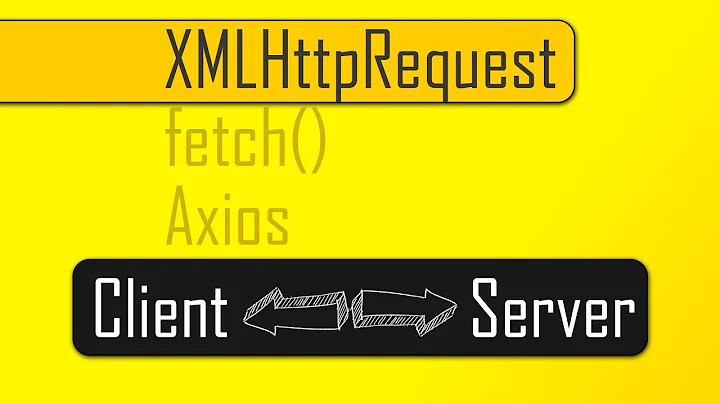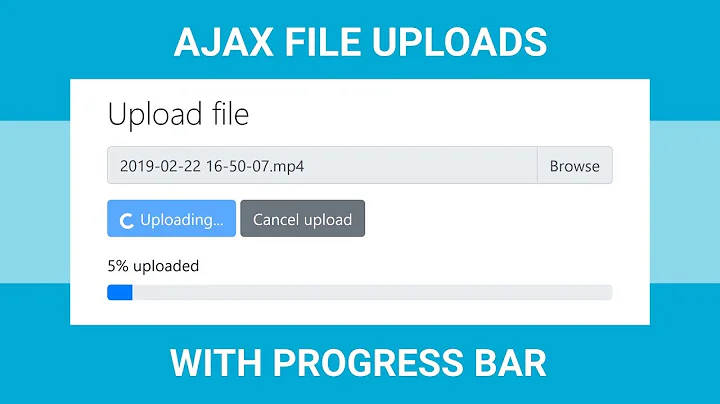Send a file as multipart through XMLHttpRequest
Solution 1
That's only possible with the XHR FormData API (previously known being part of as "XHR2" or "XHR Level 2", currently known as "XHR Advanced Features").
Given this HTML,
<input type="file" id="myFileField" name="myFile" />
you can upload it as below:
var formData = new FormData();
formData.append("myFile", document.getElementById("myFileField").files[0]);
var xhr = new XMLHttpRequest();
xhr.open("POST", "myServletUrl");
xhr.send(formData);
XHR will take care about proper headers and request body encoding and the file will in this example be available on the server side as form-data part with the name myFile.
You need to keep in mind that FormData API is not supported in older browsers. At caniuse.com you can see that it's currently implemented in Chrome 7+, Firefox 3.5+, Safari 5+, Internet Explorer 10+ and Opera 12+.
In case you're using jQuery, then you might be tempted to use its $.val() function as below:
formData.append("myFile", $("#myFileField").val());
But this is incorrect as it doesn't return the whole File object, but merely the file name as String which is utterly useless as it doesn't contain the file contents.
If you don't want to use document.getElementById() for some reason, then use one of the following instead:
formData.append("myFile", $("#myFileField").prop("files")[0]);
formData.append("myFile", $("#myFileField")[0].files[0]);
An alternative is to use the jQuery Form plugin. Your entire form, when written and functioning properly without any line of JavaScript code, will then instantly be ajaxified with just the following line:
$("#formId").ajaxForm(function(response) {
// Handle Ajax response here.
});
It also supports file uploads as well by a hidden iframe trick. See also this jQuery Form documentation for an in-depth explanation. You may only need to change the servlet code to be able to intercept on both normal (synchronous) and Ajax (asynchronous) requests. See also this answer for a concrete example: Simple calculator with JSP/Servlet and Ajax
Either way, the uploaded file should then be available in the doPost() method of a @MultipartConfig servlet as follows:
Part myFile = request.getPart("myFile");
Or if you're still on Servlet 2.5 or older, use Apache Commons FileUpload the usual way. See also this answer for a concrete example: How can I upload files to a server using JSP/Servlet?
Solution 2
It's not possible to send multipart/form-data with XMLHttpRequest (though it is possible in modern browsers, with XHR2. See BalusC's answer).
A common way to achieve what you want is to use a regular form, but in an iframe instead. This way, only the iframe is refreshed on upload.
Related videos on Youtube
Tejasva Dhyani
I love to solve problems. And at times end up creating some of them too.
Updated on October 30, 2021Comments
-
Tejasva Dhyani over 2 years
Can I send a file as multipart by XMLHttpRequest to a servlet?
I am making a form and submitting it as multipart, but somehow I am not getting a response for successfully uploading it. I do not want the page to be refreshed, so it has to take place by Ajax.
-
Rob W about 12 years
-
-
Tejasva Dhyani about 12 yearsActually I want a response whether the file is uploaded or not. Also, I want the location where the image is uploaded.
-
 Linus Thiel about 12 yearsTejasva: Look at the example from Napolux, it specifies how you can call a js function on the parent window when upload is complete. It could provide the image location as well.
Linus Thiel about 12 yearsTejasva: Look at the example from Napolux, it specifies how you can call a js function on the parent window when upload is complete. It could provide the image location as well. -
Šime Vidas about 12 years@LinusGThiel It is possible. See BalusC's answer.
-
 Linus Thiel about 12 yearsYes, it's possible with XHR2. With modern browsers, there is also FileAPI and other cool features. Perhaps I should try to explain how to accomplish this, with fallbacks for older browsers, etc. Honestly, I wasn't sure I would get that across in a good manner to the asker. I agree that BalusC's answer is better than mine.
Linus Thiel about 12 yearsYes, it's possible with XHR2. With modern browsers, there is also FileAPI and other cool features. Perhaps I should try to explain how to accomplish this, with fallbacks for older browsers, etc. Honestly, I wasn't sure I would get that across in a good manner to the asker. I agree that BalusC's answer is better than mine. -
walox over 7 yearsAnd what happen if in our page we generate automatically many input files ? can we generate IDs ?
-
Edmond Tamas over 5 years@BalusC I'm wondering why there is no info about how & why XMLHttpRequest + FormData sets headers automatically, on MDN or other places (googled a lot). Whenever I set
Content-type', 'multipart/form-data'my requests fail, but works if headers are not specified. But why?





